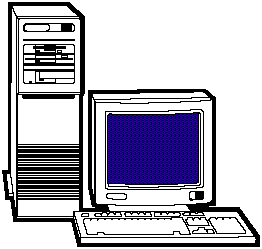
The Internet came about as a logical extension of the massive highway building campaign which took place during the 1950's when the cold war was at its height. In the name of national defense, the government under wrote the cost of constructing a system of interstate highways linking major cities across the country, and thereby allowing the military to quickly reinforce any front in case the United States was ever attacked. The basic assumption was that, if one city was destroyed, the effect on the overall flow of supplies to the rest of the country could be minimized by the availability of alternate routes bypassing the area of destruction. Similarly, the highway network would allow the military to decentralize and avoid having to rely upon a single "command headquarters" that could be targeted and put out of commission by the enemy.
This notion was also the driving idea behind the creation of the Internet. By the late 1960s, with the highway system in place and supply routes secured, the military turned its attention to securing its system of intelligence. It set about ensuring the safe transport of data between huge mainframe computers at different strategic locations by creating unlimitedalternate communication routes in case of bomb attack and by decentralizing functions so that no single computer could be targeted as an "information headquarters."
In 1969, the Department of Defense's Advanced Research Projects Agency (ARPA) created the Internet for military research purposes. But it wasn't known then as the Internet; it was called "ARPA" or "ARPA net," and it had to do with security and defense. ARPA net used myriad connections to link together four main frame computers--at Stanford Research Institute, the University of California at Los Angeles, the University of California at Santa Barbara, and the University of Utah--so that if one were taken out, information could continue to flow among the others over alternate paths. The idea was to connect the Pentagon with defense reserachers in acadamia and business. The goal was to build a decentralized network that would run even if nuclear war destroyed part of it. The network would continue to function because it did not rely on a single pathway for data transmission. This was accomplished using a new technology called packet switching. Previously, computer networking efforts required aline between each computer on the network and data moved in a continuous flow from host to host. Packet switching changed all that. It allowed data files to be broken down into chunks or "packets" of from one to around 1500 characters for random transfer to their ultimate destination. Packet switching allowed the same communication lines to be shared by many different users at the same time.
In the years that followed, the network grew. The Department of Defense concurrently developed MIL net, a network for not-so-top-secret stuff, which was linked to ARPA net . In 1986, another U.S. government agency, the National Science Foundation (NSF), set up a network of five super computer centers called NSF net. NSF net proved so successful that it eventually replaced ARPA net, which was shut down in 1990. NSF net provided additional networking links to academic institutions around the country by creating a system of smaller regional networks connecting universities to their nearest neighbors in chains that at some point connected to one of the five linked super computer centers. In this manner, any computer on any of the chains could eventually communicate with any other computer on any of the chains by forwarding the conversation through its neighbor. As the United States continued to develop its national and local networks, others countries did the same. This gave rise to connections between different national networks. The Internet, as we know it today, had come into being.

With the creation of NSF net, academia suddenly found itself with access to fast computers, previously available only to government employees and contractors, weapons developers and a few computer science researchers. With this connectivity also came access to newer, higher-level Internet working protocols (the language unlike computers use to talk to each other), such as TCP/IP. TCP and IP are two of the most important protocols; you don't need to know the details of how they work in order to appreciate what they do.The TCP part of TCP/IP assumes responsibility for breaking down the raw data into "packets" at the one end and reassembling everything correctly at theother; the IP part takes care of transferring the data packets successfully to their intended destination.
As more and more networks, both within and outside the country, "gate wayed" email access to the emerging Internet, an exchange of information on a global level followed. One of the first gateways was to BIT net, ("Because It's Time Network), an academic network of mostly mainframe computers developed in the early 1980's in response to academic researchers' needs for collaborative scholarship. (BIT net provided email and file transfer capabilities, and spawned the first LISTSERVS, i.e, electronic discussion groups, among academic institutions.) Since BIT net connections were limitedto mainframe systems and the network speeds were much slower than allowed by Internet's networking scheme, BIT net has gradually been superceded by the Internet. As of January, 1997, BIT net, like APRA net, has shut down permanently.
Throughout the 1980's, technological advances in computer hardware and software made powerful computers more accessible to the public. Better communications systems allowed more computers to link to the network. Still, during this period, computers on the Internet numbered only in the hundreds and, for the most part, were used primarily by government and scientific researchers and a few free-wheeling "teckies." Then, in 1991, Vice President Gore gave his "Information Superhighway" speech, and overnight, the "Internet" and "Information Superhighway" became household words. This was a far cry from the unenthusiactic reaction that State Representative Al Gore received in the 1980s when he called for the creation of a national network of computers or "information highways." The information superhighway idea was again proposed by President Bill Clinton in 1993 as a way to link schools, hospitals, businesses, and government agencies together all over the country. Most people describe the Internet as a highway of information for our nation. It will certainly be a highway to the future for the next generation. The vehicle for managing the information explosion of the Information Age is the computer and a major avenue to that information is the Internet.
